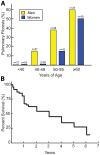Telomere lengths, pulmonary fibrosis and telomerase (TERT) mutations
- PMID: 20502709
- PMCID: PMC2873288
- DOI: 10.1371/journal.pone.0010680
Telomere lengths, pulmonary fibrosis and telomerase (TERT) mutations
Abstract
Background: Telomerase is an enzyme that catalyzes the addition of nucleotides on the ends of chromosomes. Rare loss of function mutations in the gene that encodes the protein component of telomerase (TERT) have been described in patients with idiopathic pulmonary fibrosis (IPF). Here we examine the telomere lengths and pulmonary fibrosis phenotype seen in multiple kindreds with heterozygous TERT mutations.
Methods and findings: We have identified 134 individuals with heterozygous TERT mutations from 21 unrelated families. Available medical records, surgical lung biopsies and radiographs were evaluated retrospectively. Genomic DNA isolated from circulating leukocytes has been used to measure telomere lengths with a quantitative PCR assay. We find that telomere lengths of TERT mutation carriers decrease in an age-dependent manner and show progressive shortening with successive generations of mutation inheritance. Family members without TERT mutations have a shorter mean telomere length than normal, demonstrating epigenetic inheritance of shortened telomere lengths in the absence of an inherited TERT mutation. Pulmonary fibrosis is an age-dependent phenotype not seen in mutation carriers less than 40 years of age but found in 60% of men 60 years or older; its development is associated with environmental exposures including cigarette smoking. A radiographic CT pattern of usual interstitial pneumonia (UIP), which is consistent with a diagnosis of IPF, is seen in 74% of cases and a pathologic pattern of UIP is seen in 86% of surgical lung biopsies. Pulmonary fibrosis associated with TERT mutations is progressive and lethal with a mean survival of 3 years after diagnosis. Overall, TERT mutation carriers demonstrate reduced life expectancy, with a mean age of death of 58 and 67 years for males and females, respectively.
Conclusions: A subset of pulmonary fibrosis, like dyskeratosis congenita, bone marrow failure, and liver disease, represents a "telomeropathy" caused by germline mutations in telomerase and characterized by short telomere lengths. Family members within kindreds who do not inherit the TERT mutation have shorter telomere lengths than controls, demonstrating epigenetic inheritance of a shortened parental telomere length set-point.
Conflict of interest statement
Figures




Similar articles
-
Subclinical lung disease, macrocytosis, and premature graying in kindreds with telomerase (TERT) mutations.Chest. 2011 Sep;140(3):753-763. doi: 10.1378/chest.10-2865. Epub 2011 Feb 24. Chest. 2011. PMID: 21349926 Free PMC article.
-
Telomere shortening in familial and sporadic pulmonary fibrosis.Am J Respir Crit Care Med. 2008 Oct 1;178(7):729-37. doi: 10.1164/rccm.200804-550OC. Epub 2008 Jul 17. Am J Respir Crit Care Med. 2008. PMID: 18635888 Free PMC article.
-
Adult-onset pulmonary fibrosis caused by mutations in telomerase.Proc Natl Acad Sci U S A. 2007 May 1;104(18):7552-7. doi: 10.1073/pnas.0701009104. Epub 2007 Apr 25. Proc Natl Acad Sci U S A. 2007. PMID: 17460043 Free PMC article.
-
Short telomeres in pulmonary fibrosis: from genetics to clinical significance.Pneumologia. 2015 Jan-Mar;64(1):8, 11-3. Pneumologia. 2015. PMID: 26016050 Review.
-
Telomerase and idiopathic pulmonary fibrosis.Mutat Res. 2012 Feb 1;730(1-2):52-8. doi: 10.1016/j.mrfmmm.2011.10.013. Epub 2011 Nov 4. Mutat Res. 2012. PMID: 22079513 Free PMC article. Review.
Cited by
-
Utility of whole genome sequencing in assessing risk and clinically relevant outcomes for pulmonary fibrosis.Eur Respir J. 2022 Dec 22;60(6):2200577. doi: 10.1183/13993003.00577-2022. Print 2022 Dec. Eur Respir J. 2022. PMID: 36028256 Free PMC article.
-
A Newfoundland cohort of familial and sporadic idiopathic pulmonary fibrosis patients: clinical and genetic features.Respir Res. 2012 Aug 1;13(1):64. doi: 10.1186/1465-9921-13-64. Respir Res. 2012. PMID: 22853774 Free PMC article.
-
Interstitial Lung Diseases and Non-Small Cell Lung Cancer: Particularities in Pathogenesis and Expression of Driver Mutations.Genes (Basel). 2024 Jul 17;15(7):934. doi: 10.3390/genes15070934. Genes (Basel). 2024. PMID: 39062713 Free PMC article. Review.
-
Telomeres and immune competency.Curr Opin Immunol. 2012 Aug;24(4):470-5. doi: 10.1016/j.coi.2012.05.001. Epub 2012 May 22. Curr Opin Immunol. 2012. PMID: 22626625 Free PMC article. Review.
-
Decreasing initial telomere length in humans intergenerationally understates age-associated telomere shortening.Aging Cell. 2015 Aug;14(4):669-77. doi: 10.1111/acel.12347. Epub 2015 May 7. Aging Cell. 2015. PMID: 25952108 Free PMC article.
References
-
- Greider CW, Blackburn EH. Identification of a specific telomere terminal transferase activity in Tetrahymena extracts. Cell. 1985;43:405–413. - PubMed
-
- Feng J, Funk WD, Wang SS, Weinrich SL, Avilion AA, et al. The RNA component of human telomerase. Science. 1995;269:1236–1241. - PubMed
-
- Wright WE, Piatyszek MA, Rainey WE, Byrd W, Shay JW. Telomerase activity in human germline and embryonic tissues and cells. Dev Genet. 1996;18:173–179. - PubMed
-
- Kim NW, Piatyszek MA, Prowse KR, Harley CB, West MD, et al. Specific association of human telomerase activity with immortal cells and cancer. Science. 1994;266:2011–2015. - PubMed
Publication types
MeSH terms
Substances
Grants and funding
LinkOut - more resources
Full Text Sources
Other Literature Sources
Medical

